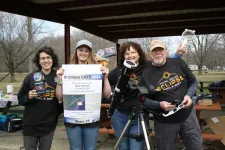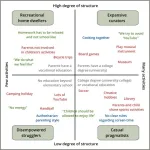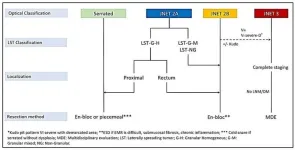(Press-News.org) INDIANAPOLIS – Screening for colorectal cancer presents a unique opportunity unavailable for most other types of cancers. Screening allows for the detection of both precancerous polyps and cancer, enabling clinicians to intervene and reduce the chances of future development of new or more advanced malignancy. However, gaps in the colorectal screening process exist. One of the most critical gaps, according to an editorial published in JAMA Network Open, is the lack of timely follow-up with a colonoscopy after a positive stool-based test.
A positive fecal immunochemical test (FIT) or multitarget stool DNA screening test requires follow up because these results suggest the presence of an abnormal growth such as a polyp or cancer. Improving follow-up rates with colonoscopy following positive results of these stool-based tests would decrease colorectal cancer incidence and deaths.
“If a stool-based test is negative, a follow-up screening test is recommended in a one-, or three-year interval depending on the type of test that was done. However, if a stool-based test is positive, regardless of the type of test that was done, a follow up colonoscopy is recommended. Follow-up should be as soon as possible. Studies show that in some settings, individuals who have positive stool tests often don’t follow up with a colonoscopy to determine whether they have cancer or polyps,” said editorial corresponding author Jennifer Maratt, M.D., M.S., of the Regenstrief Institute and Indiana University School of Medicine. “The gap is substantial with some centers reporting fewer than one in five patients having a follow up colonoscopy.
“This gap in follow-up is the elephant in the room of cancer screening – something important we need to talk about, but often don’t. Screening with stool-based tests is a two-step process. Clinicians and healthcare systems can help improve screening completion rates by educating patients about what the screening pathways will look like when selecting invasive tests such as colonoscopy, or non-invasive tests, such as stool-based tests, and what positive and negative test results mean,” she said. “By using quality measures like the colorectal cancer screening completion measure, we will be able to capture data on screening completion when a two-step process is involved and have the opportunity to address this gap. For example, we could learn from high performing centers about processes they have in place to ensure timely follow-up.”
Although stool-based colorectal screening tests are typically self-administered in the patient’s home, clinicians are involved in the process. They order the test and typically provide it to the patient. Test results are sent to the clinician and the patient is then notified of the results and given recommendation by their healthcare provider for next steps, if any, in the colorectal cancer screening process.
"Refining, testing and implementing two-step colorectal screening measures are important, necessary, and achievable goals," said editorial co-author Thomas Imperiale, M.D., of the Regenstrief Institute and IU School of Medicine. "Closing or even narrowing the post-positive stool test gap and getting these individuals in for colonoscopy is among the best use of this resource and is expected to reduce colorectal cancer incidence and mortality."
Authors of “Closing a Gap in Colorectal Cancer Screening” and affiliations are
Dr. Maratt1,2,3; David A. Leiman, M.D., MSHP4,5; and Dr. Imperiale1,2,3.
1Indiana University School of Medicine, Indianapolis, IN
2Richard L. Roudebush VA Medical Center, Indianapolis, IN
3Regenstrief Institute, Inc. Indianapolis, IN
4Division of Gastroenterology, Duke University School of Medicine, Durham, NC
5Duke Clinical Research Institute, Durham, NC
Jennifer K. Maratt, M.D., M.S.
In addition to her role as a research scientist with the William M. Tierney Center for Health Services Research at Regenstrief Institute, Jennifer K. Maratt, M.D., M.S., is an affiliate investigator for the Richard L. Roudebush VA Health Services Research and Development Center for Health Information and Communication, and assistant professor of medicine in the Division of Gastroenterology and Hepatology at Indiana University School of Medicine.
Thomas F. Imperiale, M.D.
In addition to his role as a research scientist at Regenstrief Institute, Thomas F. Imperiale, M.D., is a core investigator for the U.S. Department of Veterans Affairs Health Services Research and Development Center for Health Information and Communication, Richard L. Roudebush VA Medical Center. He is the Lawrence Lumeng Professor of Gastroenterology and Hepatology at Indiana University School of Medicine as well.
END
Critical gap in colorectal cancer screening process: follow-up after positive stool test
2024-04-22
ELSE PRESS RELEASES FROM THIS DATE:
Ion thermoelectric conversion devices for near room temperature
2024-04-22
They published their work on Apr. 10 in Energy Material Advances.
The electrode sheet of the thermoelectric device consists of ionic hydrogel, which is sandwiched between the electrodes to form, and the Prussian blue on the electrode undergoes a redox reaction to improve the energy density and power density of the ionic thermoelectric generator.
Prof. Zeng Wei of the Institute of Chemical Engineering, Guangdong Academy of Sciences, said that at the beginning, the group mainly carried out research based on the thermal diffusion effect and published a series of research results. In spite of this, their results never realized the ...
SwRI-led eclipse projects shed new light on solar corona
2024-04-22
SAN ANTONIO — April 22, 2024 —Teams led by Southwest Research Institute successfully executed two groundbreaking experiments — by land and air — collecting unique solar data from the total eclipse that cast a shadow from Texas to Maine on April 8, 2024. The Citizen Continental-America Telescopic Eclipse (CATE) 2024 experiment engaged more than 200 community participants in a broad, approachable and inclusive attempt to make a continuous 60-minute high-resolution movie of this exciting event. A nearly simultaneous investigation used unique equipment installed in NASA’s WB-57F research aircraft to chase the ...
Analyzing the impact of ovulation-inducing agents on the quality of embryo
2024-04-22
Low birth rates have become a serious problem in many developed countries throughout the world, with Japan being a prime example. In Japan particularly, aging and stress have led to a massive rise in infertility, which now affects one in every 4.4 couples. To find a workaround this condition, many couples have now turned to assisted reproduction technologies (ARTs) and in vitro fertilization (IVF) for conception. However, even though ARTs and IVF methods are well-established and have been widely used for over four decades, birth rates post IVF in Japan are still critically low, peaking at a meager 10.2%.
One of the reasons ...
Prognostic biomarkers for hepatocellular carcinoma based on serine and glycine metabolism-related genes
2024-04-22
Background and Aims
Targeted therapy and immunotherapy have emerged as treatment options for hepatocellular carcinoma (HCC) in recent years. The significance of serine and glycine metabolism in various cancers is widely acknowledged. This study aims to investigate their correlation with the prognosis and tumor immune microenvironment (TIME) of HCC.
Methods
Based on the public database, different subtypes were identified by cluster analysis, and the prognostic model was constructed through regression analysis. The gene expression omnibus (GEO) data set was used as the ...
In psychedelic therapy, clinician-patient bond may matter most
2024-04-22
COLUMBUS, Ohio – Drug effects have dominated the national conversation about psychedelics for medical treatment, but a new study suggests that when it comes to reducing depression with psychedelic-assisted therapy, what matters most is a strong relationship between the therapist and study participant.
Researchers analyzed data from a 2021 clinical trial that found psilocybin (magic mushrooms) combined with psychotherapy in adults was effective at treating major depressive disorder.
Data included depression outcomes and participant reports about their experiences ...
Family learning environments in Scandinavia: dimensions, types and socioeconomic profiles
2024-04-22
Do children have regular bedtimes and do parents enforce strict screen time policies? And do parents take their children to museums so that they can learn from an early age? Or is everyday life more about having fun together, without clear rules and any ambition to ‘develop’ children in any particular way?
Family life can be lived in many different ways, and what children bring with them from the home environment has a substantial impact on their opportunities and development later in life.
A new study from the Department of Sociology, University of Copenhagen, and VIVE - The Danish Center for Social Science Research ...
People think 'old age' starts later than it used to, study finds
2024-04-22
Middle-aged and older adults believe that old age begins later in life than their peers did decades ago, according to a study published by the American Psychological Association.
“Life expectancy has increased, which might contribute to a later perceived onset of old age. Also, some aspects of health have improved over time, so that people of a certain age who were regarded as old in the past may no longer be considered old nowadays,” said study author Markus Wettstein, PhD, of Humboldt University in Berlin, Germany.
However, the study, which was published in the journal Psychology and Aging, also found evidence that the trend of later perceived old age has slowed ...
Afib more common and dangerous in younger people than previously thought
2024-04-22
PITTSBURGH, April 22, 2024 – Atrial fibrillation (Afib), a common type of arrhythmia that is on the rise in people under the age of 65, is more dangerous in this increasingly younger population than previously thought, according to a new study published today in Circulation Arrhythmia and Electrophysiology and authored by physician-scientists at the UPMC Heart and Vascular Institute.
The study, which is among the first to examine a large group of Afib patients younger than 65 in the U.S., found that these younger patients were more likely to be hospitalized for heart failure, stroke or heart ...
To accelerate biosphere science, reconnect three scientific cultures
2024-04-22
Researchers who study Earth’s biosphere tend to operate from one of three scientific cultures, each with distinct ways of conducting science, and which have been operating mostly independently from one another, find the authors of a Perspective published in PNAS on April 19, 2024. SFI Professors Christopher Kempes and Geoffrey West, together with External Professor Brian Enquist (University of Arizona) identify and explain the three cultures, and suggest that reconnecting them could help accelerate ...
Endoscopic techniques for removing large colorectal polyps
2024-04-22
Colorectal cancer (CRC) is the second most common cancer in the United States. This highlights the importance of early detection and treatment of precancerous lesions like large polyps. Endoscopy offers a minimally invasive approach to removing these polyps, reducing the need for traditional surgery.
This review, published in eGastroenterology, explores advancements in endoscopic resection techniques, specifically Endoscopic Mucosal Resection (EMR) and Endoscopic Submucosal Dissection (ESD).
Complete removal of large polyps (>10 mm) is crucial to prevent progression to CRC. Piecemeal resection during endoscopic procedures can increase the risk ...




